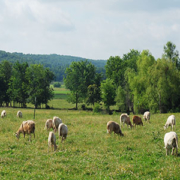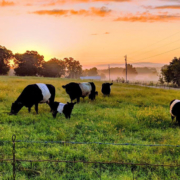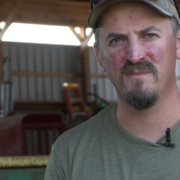Looking for On-farm Diversification? Consider Pastured Pigs
 Print This Post
Print This Post
By Mike Lewis, NCAT Sustainable Agriculture Specialist
I once had a platoon sergeant who liked to say, “the best defense is having a diversity of offense.” It wasn’t until recently that I made this connection to my farm and to my work at NCAT. One of the most common topics that I speak with farmers about is how to best diversify their operation to successfully weather the current reality we find ourselves in, the increasing cost of inputs, and the constantly changing climate, all of which make decisions even more important, as any mistake is amplified in the current environment. One of the things I truly appreciate about working at NCAT is the diversity of expertise, all focused on the same goal of supporting farmers and the environment.
While this is not a blog on farm diversity, it is always good to talk about on-farm diversification. On my family’s farm in eastern Kentucky, we are constantly evaluating our systems and looking for ways to improve our ecological and economic bottom line. Toward this goal, we made the decision several years ago to introduce pastured pigs to our operation. While this may not work for every farm, it worked very well for us.
I recently presented a webinar on farrowing pigs on pasture in partnership with the Food Animal Concerns Trust (FACT), and I was pleasantly surprised at how many people reached out to me for more information about introducing pastured pork to their operation. In response to that interest, it felt like a good time to discuss a few important considerations for producers contemplating adding pastured pork to their operation.
Why Pasture?
According to the Animal Welfare Institute, about 90% of all the pigs raised in the United States are raised in confinement, with most of those being raised on concrete. Recently, there has been an increase in pigs being raised on pasture which, from my perspective, is a good thing. There are many benefits to raising pigs on pasture, and I thought I would share my favorite three.
First, it provides our customers better-quality meat, both in taste and nutritional content, as well as in a community sense. In his book, This Holy Earth, the naturalist Liberty Bailey reminds us that, “one does not act rightly toward one’s fellows if one does not know how to act rightly towards the earth.” I always liked this quote because it articulates the point that caring for the earth and the creatures that share it with us is an act of community. Raising pigs on pasture is better for the pigs, the planet, and the community.

Photo: Mike Lewis, NCAT
Second, pigs can be an effective tool to help manage your land and improve soil fertility. On my farm, we use pigs to help clear and maintain our forests and sometimes in our gardens to help with tillage. They are an important part of our overall production system, and they can help save us time and money by doing some work for us.
Finally, pigs get to be pigs. Being on pasture allows pigs to get exercise and helps prevent stress and other diseases. With proper planning and rotations, your pigs will have a more natural diet, better attitudes, and a better quality of life. This helps with overall health and wellness of your stock, while also helping to decrease your farm’s dependence on external inputs.
Pasture Considerations
It is important to consider how pigs will fit into your farm’s rotational plan because, as we have learned from experience, pigs can go from being beneficial to being a destructive force overnight. On my family’s farm, we classify our pasture into two types, forest and field. Our stock rotates through these throughout the year, but for the most part, our pigs stay in the forest-based pasture. An important thing to consider is how much pasture you have available, and how often you can rotate those pastures. If pastures are overgrazed, or if pigs are confined in a paddock for too long, they can destroy the soil and hard pack your pastures quickly. You should spend a fair amount of time determining the number of pigs you can effectively keep on your land.
Regardless of where you intend to pasture pigs, you will need to provide them with adequate access to clean water and shelter. Our pigs are pastured a long distance from the water source, so we use a series of 350-gallon storage tanks that we fill weekly using a gas-powered pump that delivers water from a nearby spring-fed pond. While the pump and waterlines have a large upfront cost, they have paid for themselves multiple times, as we spend only about 45 minutes of labor a week topping off the tanks. In our climate, zone 6a, we need to add water heaters for about three months out of the year to ensure that the tanks do not freeze during colder nights.
One of the most important factors in determining your pasture location and layout is your ability to access the pasture when caring for your pigs. Sometimes the best pasture location can increase your workload significantly. so ybe sure you have a strategy to deal with any challenges presented by pasture location. Our shelters are simple hoop houses constructed of livestock panels that we can easily pull up and move as needed, typically every 120 days or so.
Forage
Raising pigs on pasture allows you to offset your external feed inputs, which will help improve your farm’s profitability. We breed our sows in late November or early December, which puts our farrowing date in mid-March. This timing means that from September through November, when the pigs are approaching market weight and eating a lot more, our forest pastures are filled with nuts from the Black Walnut, Hickory, and Oak trees in our pastures. Another strategy we use is to under-sow the forest with turnip and beet seed early in the spring, March and April in my climate, as these crops will provide additional fodder and ensure some dietary balance to the high-protein nuts.
As I said earlier, our pigs spend most of their time in forest-based pastures, but we do bring them into the fields throughout the season to help with clean up, tillage, and fertilization. Every year, we plant about 2 acres of corn, beans, and squash using the traditional three sisters method. In October, we move the pigs in to the three sisters plantings to glean what we left behind for them. The sows get a little fatter right before the winter and turn over the field to help prepare it for our overwinter cover crop planting. Typically, this consists of winter peas, vetch, and clover. If you are planting your fields for pasture, you might consider using a mix of alfalfa, clovers, and bluegrass. I hope this quick overview makes you want to learn more about adding pastured pigs to your operation. I encourage you all to do your research and to reach out with any questions. The introduction of pigs to a farm system can be a cost-effective way to diversify your operation and increase your on-farm revenue. Pigs are not only an important part of our operation, but they also bring us a lot of joy and humor daily. I hope you also find this to be true.
Related ATTRA Resources:
ATTRA Grazing Planning Manual and Workbook
Hogs: Pastured or Forested Production
Other Resources:
This blog is produced by the National Center for Appropriate Technology through the ATTRA Sustainable Agriculture program, under a cooperative agreement with USDA Rural Development. ATTRA.NCAT.ORG.












